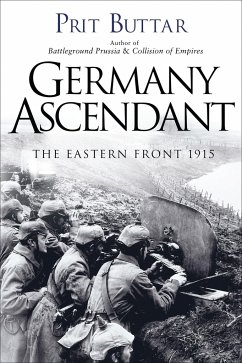While millions of men died in France and Belgium in 1915, battles equally as large and bloody were being fought on the Eastern Front, as Imperial Germany, Hapsburg Austria-Hungary, and Tsarist Russia clashed on a scale greater than anything seen on the Western Front. These massive offensives were shocking in their scale and intensity, and hugely important. Yet they are largely ignored in the West. Now, with the work of internationally renowned Eastern Front expert Prit Buttar, this story of the unknown side of World War I is finally being told. In Germany Ascendant, Buttar examines the critical year of 1915, when Germany launched the great Gorlice-Tarnow Offensive, lead by Field Marshal Mackensen. The move, which started as a minor German operation to relieve their Austro-Hungarian allies, ultimately resulted in the utter collapse of Russian forces from all of Poland and Gallacia, and came tantalizingly close to knocking Russia out of the war altogether. Next the Germans led the invasion of Serbia, leading Britain and France to intervene with ground troops, an operation that ultimately failed. Yet despite this unbroken string of successes, Germany was still hamstrung by a two-front war. Her every attempt to knock Russia out of the war--military and diplomatic--has failed. The stage was then set for the next phase of the war when Russia launched its own counter-offensive that nearly brought the Central Powers to their knees.
In this book Prit Buttar continues his analysis and narrative on what was happening on the Eastern Front in the Great War from his previous Collision of Empires: The War on the Eastern Front in 1914 [Osprey, 2014]. He continues to make the point that most scholars focus on the dreadful suffering and stalemate on the Western Front without any consideration of what was happening on the Eastern Front. This meticulous survey reveals that the Central Powers were making measurable progress to the east with the GoliceTarnow Offensive which led to the retreat of Russian forces from Poland and the occupation of Serbia, being two examples of their advances. These successes were achieved at the expense of massive human losses, basically unreported in the west. However, amidst this success, Prit Buttar does stress that leadership weaknesses on the part of the Central Powers balanced mismanagement on a massive scale by the Russians, leading to an absence of a final success for either side. Prit Buttar communicates his narrative and associated analysis in a very clear manner. This is a book for scholars with a focused interest. By contrast the enormity of the detail will deter the casual enquirer unless they are carefully guided to begin by exploring the opening and concluding chapters. These very carefully both set the scene and also explain what had happened over that year. With that preparation the interested reader might then explore some or all of the key events of the 1915 campaigns in the east. Trevor James The Historian 20150901







